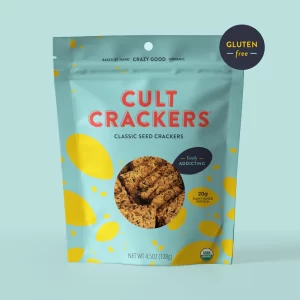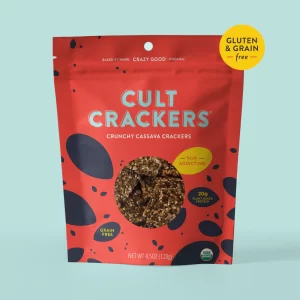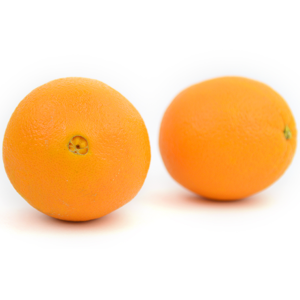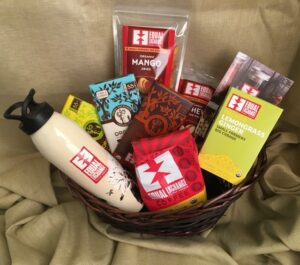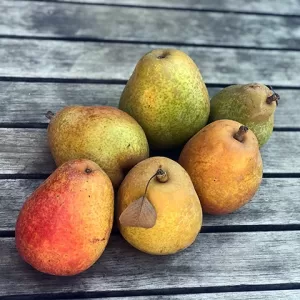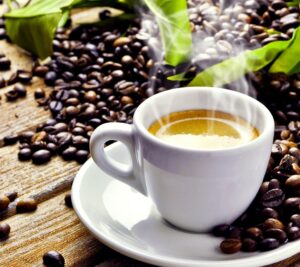Thank You Tofu Shop Specialty Foods, Inc.!
Organic Rio Red and Star Ruby Grapefruit
Season: This month our Red Rio and Star Ruby Grapefruit are grown in California. This is peak season! Grapefruit tend to grow in clusters, so much so that they can resemble grapes on a vine. (Fun fact! This is how grapefruit got their name.)
Flavor: Sweet, mildly tart, and super juicy they are mostly seedless with deep red flesh.
Storage: Store it at room temperature if you plan to eat the fruit soon, because citrus fruits are always juicier when slightly warm. If planning to store grapefruit for a longer period, make sure the skin is dry before placing the fruit in a mesh bag and store in your fridge crisper.
How to use: Many people like to eat grapefruit fresh and on its own. The juice is great but the sugar can add up quickly when you don’t have the fiber to balance it out. Grapefruit is delicious in salads, as a salsa for fish or added to your favorite grain bowl.
Nutrition: There’s a reason grapefruit is sometimes referred to as a superfood. In addition to its other health benefits, a serving of grapefruit is packed with vitamins and minerals. These include Vitamin C, Vitamin A, Calcium and Iron.
Organic Brussels Sprouts
Season: This month our Brussels Sprouts will be coming from either Mexico or California
Flavor: Raw or lightly cooked Brussels sprouts have a mild, sweet, almost nutty flavor. But they’re very easy to overcook, which can lead to a bitter taste, mushy texture, and a strong, sulfur-like smell.
Storage: Store unwashed and untrimmed in a closed container in the refrigerator.
How to use: Look for bright green Brussels sprouts. Black spots or yellow leaves are signs of decay.
To cook, rinse your sprouts well to remove any dirt. Slice off the bottom (which has a tough texture, even when cooked), and remove any outer, wilted leaves. I like to cut mine in half length wise. It helps me to keep from overcooking them. You can steam them, sauté or toss with oil and roast them. You can add raw, shaved Brussels sprouts to soups and salads.
Don’t boil your Brussels sprouts. This can lead to the mushy, bitter taste that many people hate. It also wipes out many of this veggie’s nutrients.
Nutrition: They are rich in Vitamin C, Vitamin K, Folate, Calcium, Iron and Potassium.
Organic Navel Oranges
Season: Grown in California! January through April is the best time for these. Named for the “navel” at the blossom end of the fruit, California navel oranges are considered by many to be the best oranges for eating out of hand.
Flavor: Richly flavored. Great balance of sugar and acidity. Seedless, the fruit separates into easy-to-eat segments. Has bright orange skin that peels easily when fully mature.
Storage: If you are not planning on consuming all of your navel oranges within three to four days, refrigeration is recommended. You can safely store them in the fridge for up to two weeks. The thick outer peel will protect the fruit inside but make sure you dry the outside of the fruit properly so the peel will not rot due to excessive moisture. The ideal refrigerator temperature for navel oranges is somewhere between 45 and 48 degrees. This will keep them as fresh as possible for as long as possible.
How to use: Peel and eat them! Try sectioning them to make a citrus salsa You can also juice them to make a marinade or combine pieces of fruit and juice for a sheet bake with vegetables and chicken.
Nutrition: Oranges are an excellent source of Vitamin C! Vitamin C is a powerful antioxidant, which prevents cell damage and boosts the immune system. They are also a good source of fiber, calcium, potassium and folic acid.
Sweet Potatoes or Yams?
We all love to make “yams” for Thanksgiving, but did you know that you are actually eating sweet potatoes? Perhaps you already know that they are different, but I think there are still some folks who do not. Keep reading if you want to know more.
I was a docent at The UC Botanical Garden for several years back when I had another life as a professional cook in the East Bay Area. I love learning about our foods both botanically and culturally and I hope I can interest you as well. In the United States we refer to an orange fleshed sweet potato as a yam, but they are really two completely different species. Botanically yams are a root while sweet potatoes are a stem (tuber). The true yam does not grow in the northern hemisphere. They are only grown in the Caribbean, Africa and parts of Asia. The Yam can grow up to 150lbs and 4.5′ in length. Their flesh ranges in color from white to yellow to pink and they have a very thick, scaly, alligator like skin. Their flesh is also very starchy and dry. Yams are more closely related to lilies and grasses than to sweet potatoes, which are in the morning glory family. Sweet potatoes are native to tropical regions of South America. Peruvian sweet potato remnants dating as far back as 8000 BC have been found. You can eat them raw, baked, boiled, steamed, roasted, broiled, grilled, fried and just about any other way you can think of!
There is a food origin documentary on Netflix called High on the Hog and in Episode 1 it delves into the differences between the two species and discusses how some traditional “American” dishes came into our combined cultural heritage while the origins were historically obscured. The series is based on the book “High on the Hog” by Dr. Jessica B. Harris and is well worth the read if you are at all interested in how our “American” food culture came to be. It is about the literal “roots” of our food culture.
At The Natural Grocery Company, we have a variety of different sweet potatoes to
choose from year round. The orange flesh varieties are known as “moist fleshed” and the white
fleshed varieties are known as “dry fleshed.” Here are the types we carry at both our stores:
Garnet-An orange fleshed variety that is the most popular. This is the traditional “yam” we eat at
Thanksgiving. With a dark red skin and bright pumpkin colored flesh, this sweet potato is great
prepared almost any way. It is very sweet and has a nice creamy, velvety texture when cooked.
Jewel and Beauregard-Both types have an orange flesh. These varieties have tan skin and tend
to be a little sweeter than the Garnet. I like to use the Beauregard in my sweet potato pie recipe.
It is very moist when cooked and has a texture that is not as velvety as the Garnet. Great for
making sweet potato fries or chips!
Hannah– This variety has a light tan, almost white skin with white flesh. The white flesh is
crumbly and has the texture of a russet potato when cooked. This year, I will be making a
Hannah sweet potato pie with cardamom and vanilla.
Japanese– Also a white fleshed variety, this sweet potato has a very dark purple skin. Because of
its drier texture, I like to slice these, drizzle with olive oil, cinnamon and cayenne and bake at
350 degrees until they soften and turn a golden brown color. They are also nice in soups.
Purple Stokes/ Okinawa sweet potato- This super food variety is my favorite! With a bluish
purple skin and deep royal purple flesh, this sweet potato has a texture very similar to the Garnet
but has an extra sweet earthiness to the taste. Originally from the Americas, this variety was
introduced to Japan in the 14th century and has become a staple on the Island of Okinawa where
it is eaten almost every day. This is believed to be the reason why Okinawa has the largest
percentage of people living over the age of 100 (more than any other country). This variety has
150% more antioxidants than blueberries and is wonderful prepared almost any way. Try using
these in a pie (beautiful) or mashed instead of regular potatoes.
Add some extra antioxidants to your Thanksgiving table and gain some insight into where OUR foods come from, celebrate our diversity and give thanks for the ability to come together!
By Laura Wilt, Communications & Marketing, The Natural Grocery Company
Equal Exchange Raffle, October 1-31, 2021
Organic Warren Pears
Organic Warren Pears from Frog Hollow Farms
Season: August to November in Northern California
Flavor: Sweet, juicy but mild.
Storage: Look for fruit that are unblemished and are slightly firm when you purchase them, unless you plan to eat them right away. They also smell fragrant. You can allow pears to ripen by leaving out at room temperature, uncovered, for a day or two; or you can stall the fruit’s ripening by keeping it in the refrigerator. In either case, don’t suffocate the fruit for long with airtight plastic. Without oxygen, pears will degrade faster and their natural moisture may encourage mold.
How to use: Pear ripen from the inside out; if the outside looks fully ripe then the inside may be too ripe! What pairs with pears? The answer seems to be endless. Fresh pears can be enjoyed on their own, as a snack, or in multitudes of ways. The refreshing sweetness of pears adds complexity to savory foods well, like a charcuterie or cheese board. Serving pears fresh showcases their crispness, which is lost in cooked preparations.
Like apples, though, pears can be cooked in baked goods like pies and tarts. They can be canned or turned into preserves and take on additional flavors in the process. Simply poached peeled pears in wine or brandy, until meltingly soft but still retaining their shape and serve with chocolate sauce.
Nutrition: Pears are an excellent source of dietary fiber and carbohydrates. It offers a sampling of essential minerals, including copper, iron, magnesium and calcium, although much of this nutrition is found in the fruit’s skin. The flesh alone is a good source of potassium and Vitamin C, although pears are not as strong of a source of antioxidants like higher-acidity fruits and leafy green vegetables.
Pachamama Coffee of the Month: Mexico
Mexico happens to be Pachamama’s coffee of the month, and since September marks the beginning of National Hispanic Heritage Month, we thought sharing this blog would be helpful, informative, and provide a new perspective about coffee’s wonderful, labor-love journey from seed to cup.
We present Pachamama’s latest Blog, Journey to the Origin. Their Creative Director, Rosa, recounts her discovery of coffee’s incredible journey from seed to cup while visiting one of Pachamama’s owner cooperatives: La Union Regionnal Cooperative, in Veracruz, Mexico.
We hope you find the time to read about her experience. It’s a short read that demonstrates how Pachamama Coffee is one of the most sustainable coffees the Natural Grocery can offer our customers. It is available in our El Cerrito Store.
Organic Hard-skin “Winter” Squash
Organic Hard-skin “Winter” Squash
Season: September to December in Northern California, but available year round.
Flavor: There are so many shapes, colors and sizes of winter squash that it’s a real treat to see them start to show up at the market each fall. Winter squash specifically refers to a wide variety of squash species that have matured long enough so that their skin is hard and their seeds are larger and tougher to eat than Summer Squash.
Storage: The best way to store winter squash is in a cool, dark and dry spot, where it will hold up for at least a month, even longer depending on the variety and if your storage space is well ventilated. Store cut squash in a tightly covered container and refrigerate for up to five days. You can also freeze raw squash for up to 6 months; cube first, then freeze in a single layer on a rimmed sheet tray and transfer to a freezer-safe container once frozen.
How to use: What can’t you do with winter squash? It’s wonderful roasted, stuffed, and pureed.
Thin-skinned cultivars like delicata squash cook quickly and are great combined with other vegetables or served as a side dish on their own. The skin can be eaten!
Nutrition: That beautiful orange and yellow flesh is the source of uber-powerful disease-fighting antioxidants that protect against cataracts and stroke, for starters. It’s rich in Vitamin A, B-6, C, potassium and fiber, for starters, and some heart-healthy omega-3 fatty acids as well.


